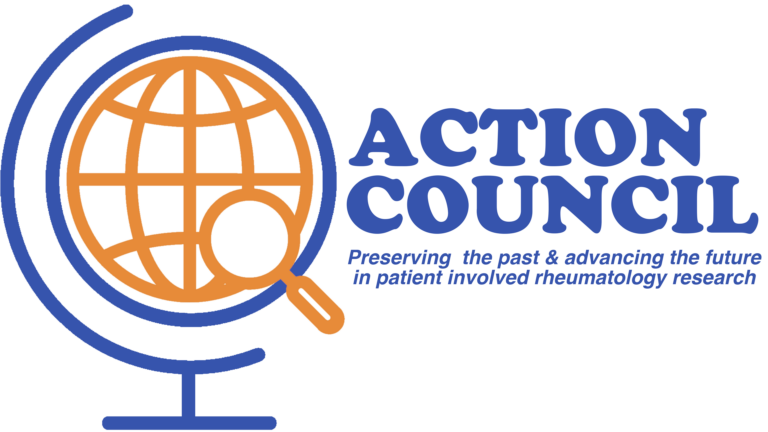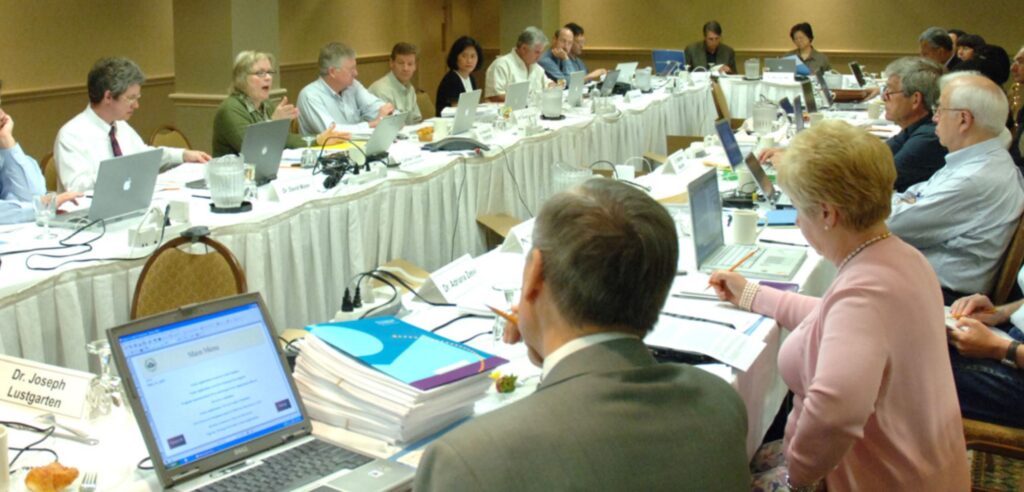United States Pathway
United States

Databanks and Registries
Databanks and registries in the rheumatology community began actively collecting relevant data from patients that can be used in both non-pharmaceutical and drug development research efforts. However, most registries – while rheumatology in nature – typically only include patients as respondents.
CoPI: Co-production of stakeholder groups
Context: Registries
Young people and families are included in research
- 2002: The Childhood Arthritis and Rheumatology Research Alliance (CARRA) Founded by a small group of pediatric rheumatologists who aimed to create an investigator-led collaborative research network by establishing a registry. The information is provided by the medical team and by patients and their families. The registry was created to monitor the long-term safety of the medications used to treat pediatric rheumatic diseases. https://carragroup.org pediatric registry is established. The founding members quickly realized that one of the best ways to achieve its primary focus was to begin a registry project. The CARRA Registry was later founded as a means to collect information about how childhood-onset rheumatic diseases are treated and how they affect patients by collecting information from the medical team, patients, and their families. United States
- 2006: The National Institute for Health Research (NIHR) (NIHR) was established in 2006 under the government’s health research strategy Best Research for Best Health to “create a health research system in which the NHS supports outstanding individuals, working in world-class facilities, conducting leading-edge research focused on the needs of patients and the public”. Since that time, we have transformed research in and for the NHS and helped to shape the health research landscape more broadly. Our mission is unchanged: to improve the health and wealth of the nation through research. We deliver against this mission through five core workstreams. www.nihr.ac.uk establishes the ‘Patient Research Ambassadors’ network and supporting GenerationRGenerationR is a National Network (GenerationR Alliance) of Young People’s Advisory Group’s (YPAGs) based across the United Kingdom to support the design and delivery of paediatric research. GenerationR Alliance YPAGs are a resource available to any health researcher (both academic and life science industries) who seek the input of children, young people, and families in their research projects www.invo.org.uk , a series of young people’s advisory groups across the country enabling children and young people under 25 to be involved in research. United Kingdom
CoPI: Advisory panels
Context: Research & Development, dissemination (knowledge translation), children, registries, young adults
Experience working with patients in research leads to guidance for best practices
As a few years have passed since patient engagement in rheumatology began, guidance and recommendations are developed based on lessons learned.
- 2010: Patient Research Partner (PRP): As a result of patient-researcher collaboration with Outcome Measures in Rheumatology (OMERACT) OMERACT is a global community for the development of Core Outcome Sets in the field of rheumatology. Patients participate as research partners in all phases of the research and are equal members in any OMERACT working group.
omeract.org; omeractprpnetwork.orgin 2002, Eueropean Alliance of Associations for Rheumatology European Alliance of Associations for Rheumatology (EULAR) European Alliance of Associations for Rheumatology (EULAR) is the organization which represents the people with arthritis/rheumatism, health professionals (HPR), and scientific societies of rheumatology of all the European nations. The aims of EULAR are to reduce the burden of rheumatic diseases on the individual and society and to improve the treatment, prevention, and rehabilitation of musculoskeletal diseases. To this end, EULAR fosters excellence in education and research in the field of rheumatology. It promotes the translation of research advances into daily care and fights for the recognition of the needs of people with musculoskeletal diseases by the governing bodies in Europe.
eular.org publishes recommendations for patient-researcher collaboration and defines the role of Patient Research Partner (PRP)Patient Research Partner (PRP) is defined as a person with a relevant disease who participates or has participated as an active research team member on an equal basis with professional researchers, thus adding the value of experiential knowledge to a research project.
and defines the role of Patient Research Partner (PRP)Patient Research Partner (PRP) is defined as a person with a relevant disease who participates or has participated as an active research team member on an equal basis with professional researchers, thus adding the value of experiential knowledge to a research project.
De Wit M, et al. European League Against Rheumatism recommendations for the inclusion of patient representatives in scientific projects. Annals of the rheumatic diseases 2011;70(5):722-6.
eular.org Europe - 2010: The University of the West of England (UWE)The University of the West of England (UWE) rheumatology group is involved in projects of regional, national, and global significance.www.uwe.ac.uk rheumatology group publishes a dedicated paper Patient collaboration in the design of Patient-Reported Outcome Measures: Capturing the Experience of Fatigue in Rheumatoid Arthritis
Nicklin J, et al. Collaboration with patients in the design of patient-reported outcome measures: Capturing the experience of fatigue in rheumatoid arthritis. Arthritis Care & Research 2010;62(11):1552-8. on patient-researcher collaboration in the development of a new patient-reported outcome (PRO) for fatigue in rheumatoid arthritis (BRAF). United Kingdom. Measures were updated in 2017.Bristol rheumatoid arthritis fatigue scales (BRAFS) are free to use for clinical or academic reasons.
www1.uwe.ac.uk/ - 2011: European Alliance of Associations for Rheumatology (EULAR) EULAR is the organization that represents the people with arthritis/rheumatism, health professionals (HPR), and scientific societies of rheumatology of all the European nations. The aims of EULAR are to reduce the burden of rheumatic diseases on the individual and society and to improve the treatment, prevention, and rehabilitation of musculoskeletal diseases. To this end, EULAR fosters excellence in education and research in the field of rheumatology. It promotes the translation of research advances into daily care and fights for the recognition of the needs of people with musculoskeletal diseases by the governing bodies in Europe.
www.eular.org establishes the network of Patient Research Partners and develops patient engagement Reference Cards and Background document . Europe
. Europe - 2012: INVOLVEINVOLVE, Establishment 1996 and funded by the National Institute for Health Research (NIHR) to support active public involvement in National Health Services (NHS) public health and social care research. As a national advisory group, the role of INVOLVE is to bring together expertise, insight, and experience in the field of public involvement in research (PIR), with the aim of advancing it as an essential part of the process by which research is identified, prioritized, designed, conducted and disseminated.
www.invo.org.uk publishes updated briefing notes for researchers . INVOLVE notes some of the content is drawn from earlier editions is substantially different in its content, reflecting the changing environment since the original briefing notes were written in 2004. United Kingdom
. INVOLVE notes some of the content is drawn from earlier editions is substantially different in its content, reflecting the changing environment since the original briefing notes were written in 2004. United Kingdom
CoPI: Patient Research Partners (PRPs), Public Involvement in Research (PIR)/Patient and Public Involvement in Research (PPI)
Tools: Recommendations – patient-researcher engagement; Reports – patient researcher engagement; Guidance documents – patient researcher engagement and briefing notes
Context: Guideline development, Patient-reported outcomes (PROs)
Concepts of Patient Involvement (CoPI) change the paradigm for patient engagement in research
- 2011: Strategy for Patient Oriented Research (SPOR): Canadian Institutes of Health Research (CIHR) Canadian Institutes of Health Research played a prominent role in the launch, implementation, and oversight of SPOR, but represents only one in a multitude of partners.cihr-irsc.gc.ca.html establishes a Strategy for Patient-Oriented Research SPOR is a collaboration of researchers, patients, provinces and territories, health care professionals, and others – all working in partnership to integrate research into patient care, ultimately improving the health of Canadians. cihr-irsc.gc.ca (SPOR) to integrate evidence in all levels of the health care system.
- 2012: Patient Research Partner (PRP): Group for Research and Assessment of Psoriasis and Psoriatic Arthritis (GRAPPA) GRAPPA is organized exclusively for non-profit, educational, and scientific purposes, specifically to facilitate the sharing of information related to psoriasis and psoriatic arthritis, networking among different medical disciplines that see psoriasis and psoriatic arthritis patients, and to enhance research, diagnosis, and treatment of psoriasis and psoriatic arthritis.
grappanetwork.org invites Patient Research Partners for the first time. In 2015, a team of Patient Research Partners was permanently added to round out their perspective first report from Patient Research Partner perspective:
De Wit M, Campbell W, FitzGerald O, Gladman DD, Helliwell PS, James J, et al. Patient Participation in Psoriasis and Psoriatic Arthritis Outcome Research: A Report from the GRAPPA 2013 Annual Meeting. The Journal of Rheumatology 2014;41(6):1206-11. - 2013: Core Outcome Measures in Effectiveness Trials (COMET)COMET brings together people interested in the development and application of agreed standardized sets of outcomes, known as ‘Core Outcome Sets’ (COS). These sets represent the minimum that should be measured and reported in all clinical trials of a specific condition, but COS are also suitable for use in routine care, clinical audit, and research other than randomized trials.
comet-initiative.org & the International Dermatology Outcome Measures (IDEOM)(IDEOM) is a non-profit organization seeking to develop and validate measures throughout dermatology with an initial focus on psoriatic disease. They strive for the establishment of patient-centric outcomes to enhance the research and treatment of dermatological conditions. Launched in 2013, IDEOM seeks to bring together physicians, researchers, government agencies, pharmaceutical companies, payers, and patients from around the globe to develop and validate measures throughout the field of dermatology with an initial focus on psoriasis.
dermoutcomes.org collaborate with Outcome Measures in Rheumatology OMERACTOMERACT is a global community for the development of Core Outcome Sets in the field of rheumatology. Patients participate as research partners in all phases of the research and are equal members in any OMERACT working group.
omeract.org to adopt the patient-centered approach of developing core outcome sets with full involvement of patients.
CoPI: Patient Research Partner (PRP), Patient-Centered Outcomes Research (PCOR), Strategy for Patient-Oriented Research (SPOR), conference participant
Context: Clinical trials, assessing grant applications, Core Outcome Set (COS)
Opportunities for patient involvement in advisory panels expands
- 2011: PCOR – Patient-Centered Research Outcomes (PCOR)Established by PCORI, this research approach is a new form of comparative effectiveness research (CER) that considers the needs and perspectives of patients and stakeholders by engaging them throughout the entire research process. www.pcori.org is established by the Patient-Centered Outcomes Research Institute (PCORI)The Patient-Centered Outcomes Research Institute (PCORI) is an independent nonprofit, nongovernmental organization and was authorized by Congress in 2010. PCORI is the largest funder of comparative effectiveness research (CER) in the United States with the mandate to improve the quality and relevance of evidence available to help patients, caregivers, clinicians, employers, insurers, and policymakers make better-informed health decisions.
www.pcori.org and enlists patients to participate in clinical research grant evaluationsPCORI also engage the public through its own institutional activities, such as Merit Review, which includes patients and stakeholders as reviewers of research applications, ensuring dollars spent are aligned with research outcomes that are meaningful to the patient population. United States View other PCORI projects that included rheumatology patients in research.
- 2012: National Institute for Arthritis and Musculoskeletal and Skin diseases (NIAMS)The mission of the National Institute of Arthritis and Musculoskeletal and Skin Diseases is to support research into the causes, treatment, and prevention of arthritis and musculoskeletal and skin diseases; the training of basic and clinical scientists to carry out this research; and the dissemination of information on research progress in these diseases.
www.niams.nih.gov adds one patient to the grant application review team. - 2012: The US Department of Defense (DoD) The Department of Defense is America’s largest government agency. With our military tracing its roots back to pre-Revolutionary times, the department has grown and evolved with our nation. Our mission is to provide the military forces needed to deter war and ensure our nation’s security. www.defense.gov created the Peer Reviewed Medical Research Program (PRMRP)PRMRP is one of 35 research programs managed by the Congressionally Directed Medical Research Programs (CDMRP). Patients/survivors/individuals living with the diseases and conditions with research programs managed by the CDMRP were incorporated into all aspects of the program cycle with equal voice to include research focus, investment strategy, and programmatic review in 1993, and into peer review in 1995.
cdmrp.army.mil adds patients/individuals living with rheumatoid arthritis and osteoarthritis as peer reviewers starting in 2012 and lupus was added in 2015. In 2017, lupus became its own research program within the Congressionally Directed Medical Research Programs (CDMRP). The CDMRP is a Department of Defense (DOD) program. that receives congressional appropriations explicitly for. biomedical research in specific, congressionally identified. health matters. cdmrp.army.mil However, patients/individuals living with lupus originally participated in peer review starting in 2005 and continue doing so in the Lupus Research Program. - 2013: Establishment of Foundation for Research in Rheumatology (FOREUM)FOREUM Foundation for Research in Rheumatology is devoted to promote research in rheumatic and musculoskeletal diseases (RMDs) as an independent research funding body in rheumatology research. Basic and applied research of highest quality is supported to reduce the burden of disease for people with RMDs.
www.foreum.org, supported by the European League Against Rheumatism (EULAR)EULAR is the organization that represents people with arthritis/rheumatism, health professionals (HPR), and scientific societies of rheumatology of all the European nations. The aims of EULAR are to reduce the burden of rheumatic diseases on the individual and society and to improve the treatment, prevention, and rehabilitation of musculoskeletal diseases. To this end, EULAR fosters excellence in education and research in the field of rheumatology. It promotes the translation of research advances into daily care and fights for the recognition of the needs of people with musculoskeletal diseases by the governing bodies in Europe. As such, they have always had their own educational program at the annual EULAR Congress meeting, but in the earlier years, the symposia they organized was mostly independent of the other congress sessions. eular.org, involves patients in the government of the foundation as well as in the review of research grant applications. - 2013: The Patient-Centered Outcomes Research Institute (PCORI)The Patient-Centered Outcomes Research Institute (PCORI) is an independent nonprofit, nongovernmental organization and was authorized by Congress in 2010. PCORI is the largest funder of comparative effectiveness research (CER) in the United States with the mandate to improve the quality and relevance of evidence available to help patients, caregivers, clinicians, employers, insurers, and policy makers make better-informed health decisions.
www.pcori.org established the Advisory Panel for Patient EngagementBy inviting the patient and caregiver community to help generate research questions, review research proposals, assist in the conduct of research, help disseminate information and evaluate impact, patient engagement ensures authentic patient-centeredness in the research process. www.pcori.org which is an advisory body that provides input and recommendations to PCORI Board of Governors, Methodology Committee, and staff to help plan, develop, implement, improve, and refine efforts toward meaningful patient-centered research. Panel members assure the highest patient engagement standards and a culture of patient-centeredness in all aspects of its work. - Most pharmaceutical companies realize the need for an internal patient engagement department. The use of Patient Advisors becomes common.
CoPI: Advisory panels , consumer reviewers, Patient-Centered Outcomes Research (PCOR)
Context: Assessing grant applications, Research & Development, Patient-Reported Outcomes (PROs)
As the value of patient engagement evolves, so does guidance and outcome focus
As the decade progresses, international efforts to expand the patient voice in rheumatology research continues. As a result, more programs that focus on patient-reported needs, guidance for involving patients in research, and reports that assess patient involvement emerge.
- 2013: Patient-Centered Outcomes Research Institute (PCORI)PCORI is an independent nonprofit, nongovernmental organization and was authorized by Congress in 2010. PCORI is the largest funder of comparative effectiveness research (CER) in the United States with the mandate to improve the quality and relevance of evidence available to help patients, caregivers, clinicians, employers, insurers, and policymakers make better-informed health decisions. In addition to requiring patient and stakeholder engagement in PCORI funded research, PCORI also engages the public through its own institutional activities, such as Merit Review, which includes patients and stakeholders as reviewers of research applications, ensuring dollars spent are aligned with research outcomes that are meaningful to the patient population. www.pcori.org began the novel funding opportunity, Eugene Washington Engagement Awards ProgramThe Eugene Washington PCORI Engagement Award program, named in honor of the first chair of PCORI’s Board of Governors, is intended to bring more patients, caregivers, clinicians, and other healthcare stakeholders into the research process. The goal is to support projects that will build a community better able to participate in patient-centered outcomes research (PCOR) and comparative clinical effectiveness research (CER) and serve as channels to disseminate study results. www.pcori.org/engagement , which supports projects that will build a community better able to participate in patient-centered outcomes research (PCOR) and comparative clinical effectiveness research (CER) and serve as channels to disseminate study results. Example of award: Matching Actions to Needs: What Matters Most to the Arthritis Community?
 – Arthritis Foundation, United States
– Arthritis Foundation, United States - 2014: Canada’s Strategy for Patient-Oriented Research (SPOR)Endorses the active partnership of patients, researchers, health professionals and decision-makers in research so as to build a sustainable and accessible health care system that optimizes the health of Canadian citizens. cihr-irsc.gc.ca publishes A Resource Guide for Research Teams and Networks
 , a living guide to support researchers, decision-makers and other relevant stakeholders involved in a wide range of SPOR-related activitiesThis resource aims to:
, a living guide to support researchers, decision-makers and other relevant stakeholders involved in a wide range of SPOR-related activitiesThis resource aims to:
1) Clarify key concepts and terms relevant to involving patients in health research such as what we mean by patients, the public and stakeholders, and the different levels and types of involvement, and the rationales and perceived benefits of patient involvement
2) Describe, at a very high level, the current state of the evidence about patient engagement with respect to the effectiveness of different methods in relation
to process and outcome measures
3) Assemble in one place, a selection of resource documents collected from leading patient engagement organizations around the world to provide basic guidance for researchers about principles and methods for involving patients
in health research. - 2014: Group for Research and Assessment of Psoriasis and Psoriatic Arthritis (GRAPPA)Group for Research and Assessment of Psoriasis and Psoriatic Arthritis (GRAPPA) is organized exclusively for non-profit, educational, and scientific purposes, specifically to facilitate the sharing of information related to psoriasis and psoriatic arthritis, networking among different medical disciplines that see psoriasis and psoriatic arthritis patients, and to enhance research, diagnosis, and treatment of psoriasis and psoriatic arthritis.
www.grappanetwork.org publishes Patient Participation in Psoriasis and Psoriatic Arthritis Outcome Research report , co-authored by Patient Research Partners (PRPs)Patient Research Partner (PRP) is defined as a person with a relevant disease who participates or has participated as an active research team member on an equal basis with professional researchers, thus adding the value of experiential knowledge to a research project. After this publication, GRAPPA publishes annual patient reports through 2018.
, co-authored by Patient Research Partners (PRPs)Patient Research Partner (PRP) is defined as a person with a relevant disease who participates or has participated as an active research team member on an equal basis with professional researchers, thus adding the value of experiential knowledge to a research project. After this publication, GRAPPA publishes annual patient reports through 2018. - 2014: Cochrane Musculoskeletal Consumer Group (CMSG)Formed in 1993, enlisting patient systematic reviewers to join health care professionals and researchers belonging to Cochrane. “The feedback provides a layperson’s perspective to complement the feedback provided by our clinical experts.” musculoskeletal.cochrane.org updates recommendations to aid knowledge translation and exchange between clinicians and consumers
 .
.
CoPI: Patient Research Partners (PRPs), Patient-Oriented Research (POR), Patient-Centered Outcomes Research (PCOR)
Tools: Guidance – patient-researcher engagement; Reports – patient researcher engagement, patient engagement, and dissemination; Instruments – patient engagement
Context: Patient-reported outcomes (PROs), Clinical Effectiveness Research (CER)/decision science, dissemination/knowledge translation
Focus on expanding PCOR leads to the established of collaborative communities – United States
- 2013: PCORnet PCORnet is a national resource that offers the kind of research ecosystem that has long been pursued: a fully integrated network where vast, highly representative health data, research expertise, and patient insights are built-in and accessible from the very start. The infrastructure of PCORnet is well established, meaning that the community knows how to maximize the value of these connections to deliver fast, trustworthy answers that advance public health. pcornet.org – The era of big data, loosely defined as the development and analysis of large or complex data sets, the Patient-Centered Outcomes Research Institute (PCORI) The Patient-Centered Outcomes Research Institute (PCORI) is an independent nonprofit, nongovernmental organization and was authorized by Congress in 2010. PCORI is the largest funder of comparative effectiveness research (CER) in the United States with the mandate to improve the quality and relevance of evidence available to help patients, caregivers, clinicians, employers, insurers, and policymakers make better-informed health decisions.
www.pcori.org establishes PCORnet, bringing new opportunities to empower patients and their families to generate, collect, and use their health information for both clinical and research purposes. Through PCORnet, a “network of networks” was established– Patient-Powered Research Networks (PPRNs), built and governed by stakeholder groups focused on specific conditions and community interests. Learn more about PPRN’s .
.
Two rheumatology specific PPRN’s were developed, including:
- 2015: ArthritisPowerVisit the ArthritisPower.org website for products and/or info about how to get involved. led by CreakyJointsCreakyJoints is a digital community for millions of arthritis patients and caregivers worldwide who seek education, support, advocacy, and patient-centered research. CreakyJoints is a part of the non-profit Global Healthy Living Foundation, which receives funding from grants and sponsorships from pharmaceutical manufacturers, private foundations, and government-sponsored research grants. They frequently collaborate on research with major research institutions and universities.
creakyjoints.org. ArthritisPower is a non-profit, patient-inspired, and patient-managed research initiative that helps patients make a difference in the fight against arthritis and related conditions. View ArthritisPower overview, includes links to publications .
. - 2015: Patients, Advocates and Rheumatology Teams Network for Research and Service (PARTNERS) PARTNERS is a PPRN linking patients, family members, caregivers, researchers, healthcare providers, and other people interested in pediatric rheumatic diseases. Through PARTNERS, patients, family members, and other caregivers are able to share research ideas, work on proposals, and join study teams. www.arthritis.org/science ) – led by healthcare providers, Childhood Arthritis and Rheumatology Research Alliance (CARRA)Childhood Arthritis and Rheumatology Research Alliance (CARRA) was founded by a small group of pediatric rheumatologists who aimed to create an investigator-led collaborative research network by establishing a registry. The information is provided by the medical team and by patients and their families. The registry was created to monitor the long-term safety of the medications used to treat pediatric rheumatic diseases.
carragroup.org/, the US Arthritis FoundationThe Arthritis Foundation boldly pursues a cure for America’s #1 cause of disability while championing the fight against arthritis with life-changing resources, science, advocacy, and community connections. https://www.arthritis.org/, Friends of CARRA, the Lupus Foundation of AmericaLupus Foundation of America’s mission is to improve the quality of life for all people affected by lupus through programs of research, education, support, and advocacy.
www.lupus.org/, and a quality-improvement learning network (Pediatric Rheumatology Care and Outcomes Improvement Network, or PR-COIN)Pediatric Rheumatology Care and Outcomes Improvement Network (PR-COIN) works to improve outcomes and provide safe, effective, efficient, timely, patient-centered, and equitable care for all children with rheumatic conditions. Our goals are to increase remission and clinically inactive disease rates among children with JIA, improve quality of life including optimal physical function and pain, and support families in managing their child’s condition.
https://pr-coin.org/. View summary overview of PARTNERS .
. - 2015 PCORnet Assessment: Report evaluating the strengths and weaknesses of the initial phase dedicated to building its governance, technical, and research infrastructure. View report
 .
.
CoPI: Patient-Centered Outcomes Research (PCOR), co-production of stakeholder groups, patient-powered networks
Tools: Reports – patient research engagement
Context: Registries, patient-powered registries, children
Establishment and Evolution of the Patient-Focused Drug Development Initiative
Patient-focused drug development (PFDD) is a systematic approach to help ensure that patients’ experiences, perspectives, needs, and priorities are captured and meaningfully incorporated into drug development and evaluation. The primary goal of patient-focused drug development is to better incorporate the patient’s voice in drug development and evaluation
- 2012: The Food and Drug Administration (FDA)Food and Drug Administration’s (FDA) evaluation of new medicines (United States). During clinical trials, researchers study whether new medicines are safe and effective for patients and whether the medicine’s benefits outweigh the risks.
www.fda.gov/ established the PFDD initiative under the Prescription Drug User Fee Act (PDUFA V)2012, the US President signed into law the Food and Drug Administration Safety and Innovation Act (FDASIA) to include the reauthorization of the Prescription Drug User Fee Act (PDUFA) that provides FDA with the necessary resources to maintain a predictable and efficient review process for human drug and biologic products.
www.fda.gov. - 2016: The National Psoriasis FoundationNational Psoriasis Foundation (NPF) drives efforts to cure psoriatic disease and to improve the lives of those affected.
www.psoriasis.org a public meeting to hear perspectives from psoriasis patients, caregivers, and other patient representatives on the most significant dermal or skin-related effects of the disease. Publishes Voice of the Patient report . While attendees were not asked to focus on the arthritic component, a large percentage of comments and concerns included those with Psoriatic Arthritis.
. While attendees were not asked to focus on the arthritic component, a large percentage of comments and concerns included those with Psoriatic Arthritis. - 2017: The Arthritis Foundation
The Arthritis Foundation boldly pursues a cure for America’s #1 cause of disability while championing the fight against arthritis with life-changing resources, science, advocacy, and community connections. www.arthritis.org hosts the first externally ledExternally-led means it was not commissioned by the FDA so nonprofit organization(s) raise funds to host a meeting offsite. Patient-Focused Drug Development (PFDD) meeting for Osteoarthritis and, as a result, publishes OA Voice of the Patient ReportVisit www.arthritis.org to view videos and more information about this PFDD. You can also download the Report HERE .
. - 2017: Lupus and Allied Diseases AssociationThe Lupus and Allied Diseases Association, Inc., is an all-volunteer national non-profit dedicated to enhancing quality of life for those impacted by lupus and allied diseases and other conditions of unmet needs by fostering collaboration among stakeholders, promoting unity in the community, and participating in innovative advocacy, awareness and biomedical research initiatives www.ladainc.org , the Lupus Research AllianceThe Lupus Research Alliance is the largest nongovernmental, nonprofit funder of lupus research worldwide. The organization aims to transform treatment while advancing toward a cure by funding the most innovative lupus research; fostering diverse scientific talent; stimulating collaborations; and driving discovery toward better diagnostics, improved treatments and, ultimately, a cure for lupus. www.lupusresearch.org , and the Lupus Foundation of America unite to host an externally-led PFDD meeting for lupus. Publishes Lupus: Patient Voices reportVisit www.lupuspfdd.org to learn more about this PFDD. The full report can be downloaded HERE
 .
. - 2018 – 2019: FDA develops PFDD guidance materialsInformation and documents related to FDA’s development of the methodological PFDD guidance, including public workshops, draft guidance, and hypothetical scenarios, which are all intended to serve as a basis for dialogue.
View guidance materials at:
www.fda.gov to improve efforts to gain patient input and assessing outcomes in regulatory engagement. - 2019: FasterCuresFasterCures, a center of the Milken Institute works to build a system that is effective, efficient, and driven by a clear vision: working with our partners to build a patient-centric system where science is accelerated, unnecessary barriers are overcome, and lifesaving and life-enhancing treatments get to those who need them as rapidly as possible.
https://milkeninstitute.org publishes a guide for patient advocacy organizations interested in hosting, or are currently planning, an externally led PFDD meeting. The guide includes links to other tools for planning PFDD meetings, including the PFDD Meeting Tracker, the PFDD Readiness Assessment, and the PFDD Community Toolbox.
interested in hosting, or are currently planning, an externally led PFDD meeting. The guide includes links to other tools for planning PFDD meetings, including the PFDD Meeting Tracker, the PFDD Readiness Assessment, and the PFDD Community Toolbox.
CoPI: Patient-Focused Drug Development (PFDD), regulatory reviewers
Tools: Guidance Documents – patient-focused drug development (PFDD); Reports – patient-focused drug development (PFDD)
Context: Regulatory process, clinical trials, Research & Development, guideline development
Patient engagement in research is here to stay – the growth of patient-centered research conferences
Blended Engagement Conferences
- 2014: Since the launch and success of patient-engagement conferences in the United States and Europe in 2014, stakeholders in search of information to help improve collaboration efforts has surged. However, most include sessions that merge various disease groups, who utilize different Concepts of Patient Involvement (CoPI) Concepts of Patient Involvement (CoPI) define methods of engagement that involve patients in the research process. Some CoPIs have published guidance associated with them, which is recommended to follow by others planning to use the same term. and whose communities have disease-specific engagement barriers that are not considered. For those new to the patient engagement in the research space, this can cause confusion and the adaptation of terms and processes that were established in one community may not translate to the next. This can lead to issues with value measurements, particularly if the same term is used with different collaborative methods.
- This problem was demonstrated in 2014, during a US Patients as Partners meeting, when audience members requested clarification of the term Patient Research Partner (PRP)Patient Research Partner (PRP) is defined as a person with a relevant disease who participates or has participated as an active research team member on an equal basis with professional researchers, thus adding the value of experiential knowledge to a research project., which was used by several presenters but the method of engagement varied. This moment contributed to the realization that a rheumatology-specific Council may be necessary (See ACTion Council, 2018).
“Patients Included” Events
- 2015: PCORI’s first Annual Meeting in 2015 brought together more than 1,100 members of the Patient-Centered Outcomes Research Institute (PCORI)PCORI is an independent nonprofit, nongovernmental organization and was authorized by Congress in 2010. PCORI is the largest funder of comparative effectiveness research (CER) in the United States with the mandate to improve the quality and relevance of evidence available to help patients, caregivers, clinicians, employers, insurers, and policymakers make better-informed health decisions.
www.pcori.org community, including patients, researchers, and other health care stakeholders. PCORI has had meetings every year since 2015 and all have been designated as a “Patients Included” event, meaning, patients and caregivers are involved as full participants in the event’s planning and delivery, and necessary accommodations are provided for patients and caregivers to facilitate their participation.
CoPI: Patient Research Partner (PRP), Patient-Centered Outcomes Research (PCOR), conference participant
Patient Engagement in the Regulatory Process – Tools Emerge
Patient testimony in the regulatory process expands in the second half of this decade and the Food and Drug Administration (FDA)Food and Drug Administration’s (FDA) evaluation of new medicines (United States). During clinical trials, researchers study whether new medicines are safe and effective for patients and whether the medicine’s benefits outweigh the risks.
www.fda.gov and the European Medicines Agency (EMA) EMA is a decentralized agency of the European Union (EU) responsible for the scientific evaluation, supervision, and safety monitoring of medicines in the EU www.ema.europa.eu join forces!
In addition to the European Medicines Agency EMA recently revising their original framework for interaction between the agency and patients and consumers and their organizations (2014) ![]() :
:
- 2015: The FDA launches the Patient Engagement Advisory Committee (PEAC)Patient Engagement Advisory Committee (PEAC) – Food and Drug Administration (FDA) committee providing advice to the Commissioner or designee on complex issues relating to medical devices, the regulation of devices, and their use by patients.
www.fda.gov/patients to provide advice relating to medical devices . CoPI: Patient Preference Information (PPI)PPI: Qualitative or quantitative assessments of the relative desirability or acceptability to patients of specified alternatives or choices among outcomes or other attributes that differ among alternative health interventions. is established to describe this patient engagement. PPI framework and guidance released for the Center for Devices and Radiological Health (CDRH)(CDRH) recognizes that scientists, clinicians, device developers, and regulators play critical roles in evaluating and communicating the benefits and risks of medical devices. However, only patients live with their medical conditions and make daily choices regarding their health care. Their voice and perspective are critical to understanding the impact of medical devices.
. CoPI: Patient Preference Information (PPI)PPI: Qualitative or quantitative assessments of the relative desirability or acceptability to patients of specified alternatives or choices among outcomes or other attributes that differ among alternative health interventions. is established to describe this patient engagement. PPI framework and guidance released for the Center for Devices and Radiological Health (CDRH)(CDRH) recognizes that scientists, clinicians, device developers, and regulators play critical roles in evaluating and communicating the benefits and risks of medical devices. However, only patients live with their medical conditions and make daily choices regarding their health care. Their voice and perspective are critical to understanding the impact of medical devices.
www.fda.gov/about-fda/fda-organization medical device decision-making. - 2016: FDA and the EMA create a new workgroup on patient engagement called the FDA/EMA Patient Engagement ClusterWork group that allows FDA and EMA to share best practices involving patients along drug and biologic regulatory lifecycles. Information that is discussed is covered by confidentiality agreements signed by the FDA and EMA.
www.fda.gov/patients to share best practices involving patients along with drug and biologic regulatory lifecycles. - 2017: FDA launches Patient Engagement Collaborative The Patient Engagement Collaborative (PEC) is a group of patient organizations and individual representatives who discuss how to achieve more meaningful patient engagement in medical product development and other regulatory discussions at the FDA. The PEC was established by the FDA and the Clinical Trials Transformation Initiative (CTTI), a public-private partnership that brings together organizations and individuals representing academia, clinical investigators, government and regulatory agencies, industry, institutional review boards, patient advocacy groups and others to develop evidence-based solutions to clinical research challenges. www.fda.gov/patients with the Clinical Trials Transformation Initiative (CTTI)The FDA, together with the Clinical Trials Transformation Initiative, established a group of patient organization and individual representatives to discuss topics focusing on enhancing patient engagement in medical product development and regulatory discussions at FDA.
www.ctti-clinicaltrials.org/ to develop guidance materials for including patients in the R & D continuum. This collaborative was modeled after the European Medicines Agency (EMA)’s Patients’ and Consumers’ Working PartyEMA is a decentralized agency of the European Union (EU) responsible for the scientific evaluation, supervision, and safety monitoring of medicines in the EU. The Patients’ and Consumers’ Working Party (PCWP) provides a platform for exchange of information and discussion of issues of common interest between EMA and patients and consumers. www.ema.europa.eu/en/committees.
for including patients in the R & D continuum. This collaborative was modeled after the European Medicines Agency (EMA)’s Patients’ and Consumers’ Working PartyEMA is a decentralized agency of the European Union (EU) responsible for the scientific evaluation, supervision, and safety monitoring of medicines in the EU. The Patients’ and Consumers’ Working Party (PCWP) provides a platform for exchange of information and discussion of issues of common interest between EMA and patients and consumers. www.ema.europa.eu/en/committees. - 2017: EMA involves young people in their activities and establishes the principles for the involvement of young patients, consumers, and their carers, in the Agency’s scientific committees and working parties in a consistent and efficient manner
 .
. - 2017: EMA begins holding public hearings to give European citizens a voice in the evaluation of the safety of medicines and empower them to express their views on issues related to the safety of certain medicines and the management of risks.
- 2017: EMA expands opportunities to acquire patients’ perspectives on benefit/risk considerations within the Committee for Medicinal Products for Human Use (CHMP)(CHMP) is the European Medicines Agency’s (EMA) committee responsible for human medicines. The CHMP replaced the former Committee for Proprietary Medicinal Products (CPMP) in May 2004.www.ema.europa.eu/en/committees meetings.
CoPI: Regulatory reviewers, working groups, advisory panels, Patient Preference Information (PPI)
Tools: Frameworks – regulatory; Guidance Documents – patient engagement
Context: Regulatory process, clinical trials, Research & Development, health technology assessment (HTA), decision aids, young adults
Rheumatology Scientific Meetings Continue to Unite Researchers, Rheumatologists, and Patients
While the European League Against Rheumatism (EULAR)EULAR is the organization that represents people with arthritis/rheumatism, health professionals (HPR), and scientific societies of rheumatology of all the European nations. The aims of EULAR are to reduce the burden of rheumatic diseases on the individual and society and to improve the treatment, prevention, and rehabilitation of musculoskeletal diseases. To this end, EULAR fosters excellence in education and research in the field of rheumatology. It promotes the translation of research advances into daily care and fights for the recognition of the needs of people with musculoskeletal diseases by the governing bodies in Europe. As such, they have always had their own educational program at the annual EULAR Congress meeting, but in the earlier years, the symposia they organized was mostly independent of the other congress sessions. eular.org has always involved patients at their annual Congress, the American College of Rheumatology (ACR)American College of Rheumatology (ACR) is a professional membership organization whose mission is to empower rheumatology professionals to excel in their specialty. They are committed to improving the care of patients with rheumatic disease and advancing the rheumatology subspecialty.
www.rheumatology.org had a slower start.
- 2016: 1st patient-centered research study group is held at the American College of Rheumatology (ACR) annual meeting.
- 2017: EULAR Standing Committee of People with Arthritis/Rheumatism in Europe (PARE)(EULAR PARE) is the Committee within EULAR comprised of representatives and musculoskeletal user groups around Europe to work together towards improving the quality of life for people in Europe living with these conditions, with the vision to empower and help them lead full and independent lives.
www.eular.org/pare initiate the EULAR study group for collaborative research. The EULAR study group meets annually during the EULAR congress and reports progress and activities through an electronic poster. The study group for collaborative research is meant to bring together physicians/researchers and PRPs. It provides a great opportunity to exchange new experiences and developments and discuss trendy topics. View meeting overview .
. - 2017: The ACR invites patients, for the first time, to present research posters.
CoPI: Patient-Centered Outcomes Research (PCOR), Patient Research Partners (PRP), conference participant
Tools: Report – patient engagement
Context: Poster presentations, study groups
Precision Medicine in Rheumatology is on the Horizon
- 2017: While Precision Medicine (PM) Precision Medicine is a medical approach that proposes to prevent and treat disease based upon a person’s unique genetic makeup and their lifestyle habits. Precision medicine, the ability to accurately measure specific predictors of patient outcomes is implemented in personalized clinical care. research has progressed in oncology for years, only recently has there been a focus in the rheumatology spaces. As treat-to-target (T2T)T2T is a medical strategy that sets remission – defined as the absence of signs and symptoms of significant inflammatory disease activity – or low disease activity as a goal. Specific disease management targets are set. Then disease activity may be measured as frequently as monthly through lab tests and clinical examinations. If the targets are not reached, medications and/or doses are adjusted according to a predefined protocol. The process continues until the goal is achieved. www.aiarthritis.org/precisionmedicine treatment protocols prove successful, and the complexity of rheumatic diseases is realized, efforts to advance science towards precision treatments have continued to evolve.
- 2019: Preparing Patients for Precision Medicine Project – (Underway) – Developing a patient-led shared decision-making tool to help patients talk to their doctors about participating in future precision medicine trials, which will include patients who will may differ from those currently enrolled (general patient population versus atypical presentation). Learn more. – International Foundation for Autoimmune & Autoinflammatory Arthritis (AiArthritis) AiArthritis helps others, like us, living with autoimmune or autoinflammatory diseases that include inflammatory arthritis as a major clinical component, have a voice – alongside other stakeholders as equals – so, together, we can solve problems that impact education, advocacy, and research.www.aiarthritis.org
, professional advisor OMERACT.
CoPI: Research advocacy, Mentor Assisted Research (MAR)
Context: Precision medicine, clinical trials, decision aids
Compensating Patient Partners – Guidance Emerges
Patients, care partners, and patient groups involved in patient engagement activities should be compensated as lived experience experts. Over the years, as more patient voices in research have emerged, various levels of expertise have also evolved. What should you pay these engagement partners for participation in your project?
- 2019: National Health CouncilThe National Health Council provides a united voice for the 160 million people living with chronic diseases and disabilities and their family caregivers. nationalhealthcouncil.org (United States) publishes a Fair-Market Value (FMV) Calculator to determine compensation based on level of expertise. View Patient Engagement Activities Framework document guide
 .
. - 2018: Canadian Arthritis Patient Alliance (CAPA)Canadian Arthritis Patient Alliance (CAPA) works to improve access to medications, health care professionals, and services, Increase patient involvement in arthritis research and policy agendas, and understand and influence research and treatments. arthritispatient.ca and the Rare Disease FoundationRare Disease Foundation is led by rare disease patients, caregivers, researchers, and practitioners who share the same sense of urgency and values about access to resources and research for rare disease patients and their families. rarediseasefoundation.org (Canada) defining core principles behind compensation, outlining how to put those principles into practice in a valid, credible manner that honors and values the contributions of patients and families whether in quality improvement or health research
 .
.
- 2020: Canadian Arthritis Patient Alliance (CAPA) and the Rare Disease Foundation (Canada) publish additional practical recommendations related to compensation
 for Patient Research Partners (PRPs).
for Patient Research Partners (PRPs).
- 2020: Canadian Arthritis Patient Alliance (CAPA) and the Rare Disease Foundation (Canada) publish additional practical recommendations related to compensation
- Some groups, like Outcome Measures in Rheumatology (OMERACT)Outcome Measures in Rheumatology (OMERACT), is a global community for the development of Core Outcome Sets in the field of rheumatology. Patients participate as research partners in all phases of the research and are equal members in any OMERACT working group. omeract.org, omeractprpnetwork.org, are all volunteer organizations. In these cases, when other stakeholders are also donating their time, it is acceptable to expect patient partners to donate their time, too.
CoPI: Patient Research Partners
Tools: Recommendations – compensation
Context: Compensation
Pharmaceutical Companies Expand the Role of the Patient Advisory Panel
- 2020: Bristol-Myers Squibb (BMS)We are a global biopharmaceutical company whose mission is to discover, develop and deliver innovative medicines that help patients prevail over serious diseases. www.bms.com initiates PEER (Patient Expert Engagement Resource) PEER ensures that the patient perspective is heard and considered at every step of the drug discovery and development process www.bms.com/life-and-science , an enterprise-wide approach that enlists the help of “expert” patient advocates to provide insights on drug development, clinical trials, lay summaries, regulatory, access/reimbursement, and policy discussions to accelerate and improve the delivery of therapies to patients.
CoPI: Advisory panels
Context: Lay summaries, regulatory process, clinical trials, Research & Development
Rheumatology Registries and Research Front and Center
With the onset of the global pandemic of COVID-19COVID-19 is the disease caused by SARS-CoV-2, the coronavirus that emerged in December 2019. www.hopkinsmedicine.org/health/conditions-and-diseases/coronavirus , rheumatology registries – come existing and some forming solely for this reason – began focusing strongly on tracking cases in rheumatology patients. Some of these registries included the patient voice in various phases of data collection.
- 2020: COVID-19 Global Rheumatology Alliance (GRA)The mission of the GRA is to collect, analyze and disseminate information about COVID-19 and rheumatology to patients, physicians, and other relevant groups to improve the care of patients with rheumatic disease.
rheum-covid.org/ was developed to collect, analyze, and disseminate information about COVID-19 and rheumatology to patients, physicians, and other relevant groups to improve the care of patients with rheumatic disease. In addition to establishing a Patient Board, patients were invited to submit and review questions as part of the Patient Experience Survey and help develop lay summaries. International - 2020: The Arthritis & Rheumatic Disease COVID-19 Project From conception to development and launch, the Arthritis and Rheumatic Disease COVID-19 project included patients during all phases of the project, which began by learning about the impact of COVID-19 on people who are living with underlying chronic disease through multiple conversations. Patients also collaborated with researchers and clinicians to help develop and refine the survey, prioritize survey questions, provide input on the study timeline, and strategize on dissemination efforts.
rheumcovid19project.org/ – A patient-powered study of the Autoimmune Research Collaborative, from conception to development and launch, the Arthritis and Rheumatic Disease COVID-19 project included patients during all phases of the project. Respondents are asked to participate at multiple time points to better understand concerns, behaviors, and the pandemic’s overall impact on them over time. The study will also inform the preparedness of patients and clinicians for future pandemics and provide a better understanding of concerns with infection in general among patients with autoimmune disease. Led by Global Healthy Living Foundation/CreakyJoints. United States, Canada
CoPI: Advisory panel, working group, co-production of stakeholder groups
Context: Registries, lay summaries, dissemination (knowledge translation)
Shining a Light on Health Equity, Diversity, and Inclusion
- 2020: COVID-19 brought to light many inequalities in healthcare, including disparities based on socioeconomic factors and societal structure. In the United States, the realities of systemic bias and structural racism emerged, presenting the opportunity to increase efforts to advance health equity – and work to eliminate health inequities nationwide.
- 2020: In November, for the first time at a scientific conference, the American College of Rheumatology (ACR) American College of Rheumatology (ACR) is a professional membership organization whose mission is to empower rheumatology professionals to excel in their specialty. They are committed to improving the care of patients with rheumatic disease and advancing the rheumatology subspecialty.
www.rheumatology.org/ Convergence virtual meeting included a track dedicated to diversity, inclusion, and racial disparities. Session topics and abstracts focused on unconscious bias, racial barriers to care, and LGBTQ+ community education. Persons living with rheumatic diseases were included in many presentations and actively participated in coordinating online chats.
Abstract: Impact of the COVID-19 Pandemic on Racial and Ethnic Minority Groups Diagnosed with Rheumatic Disease ![]() – Presented by the COVID-19 Global Rheumatology AllianceCOVID-19 Global Rheumatology Alliance (GRA) aims to collect, analyze and disseminate information about COVID-19 and rheumatology to patients, physicians and other relevant groups to improve the care of patients with rheumatic disease. Their vision is to bring together the global rheumatology community to curate and disseminate accurate and comprehensive knowledge to advance rheumatology care in the COVID-19 pandemic.https://rheum-covid.org/
– Presented by the COVID-19 Global Rheumatology AllianceCOVID-19 Global Rheumatology Alliance (GRA) aims to collect, analyze and disseminate information about COVID-19 and rheumatology to patients, physicians and other relevant groups to improve the care of patients with rheumatic disease. Their vision is to bring together the global rheumatology community to curate and disseminate accurate and comprehensive knowledge to advance rheumatology care in the COVID-19 pandemic.https://rheum-covid.org/
CoPI: Conference participant
Tools: Report – health equity
Contexts: Registries
















